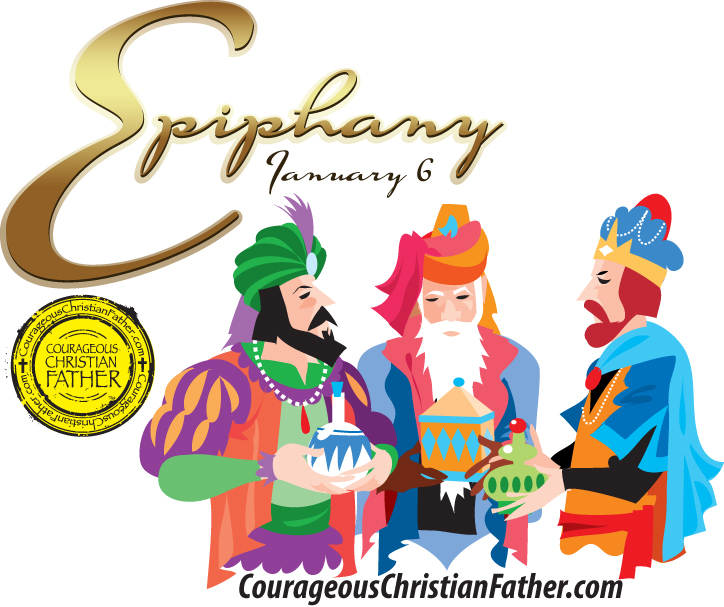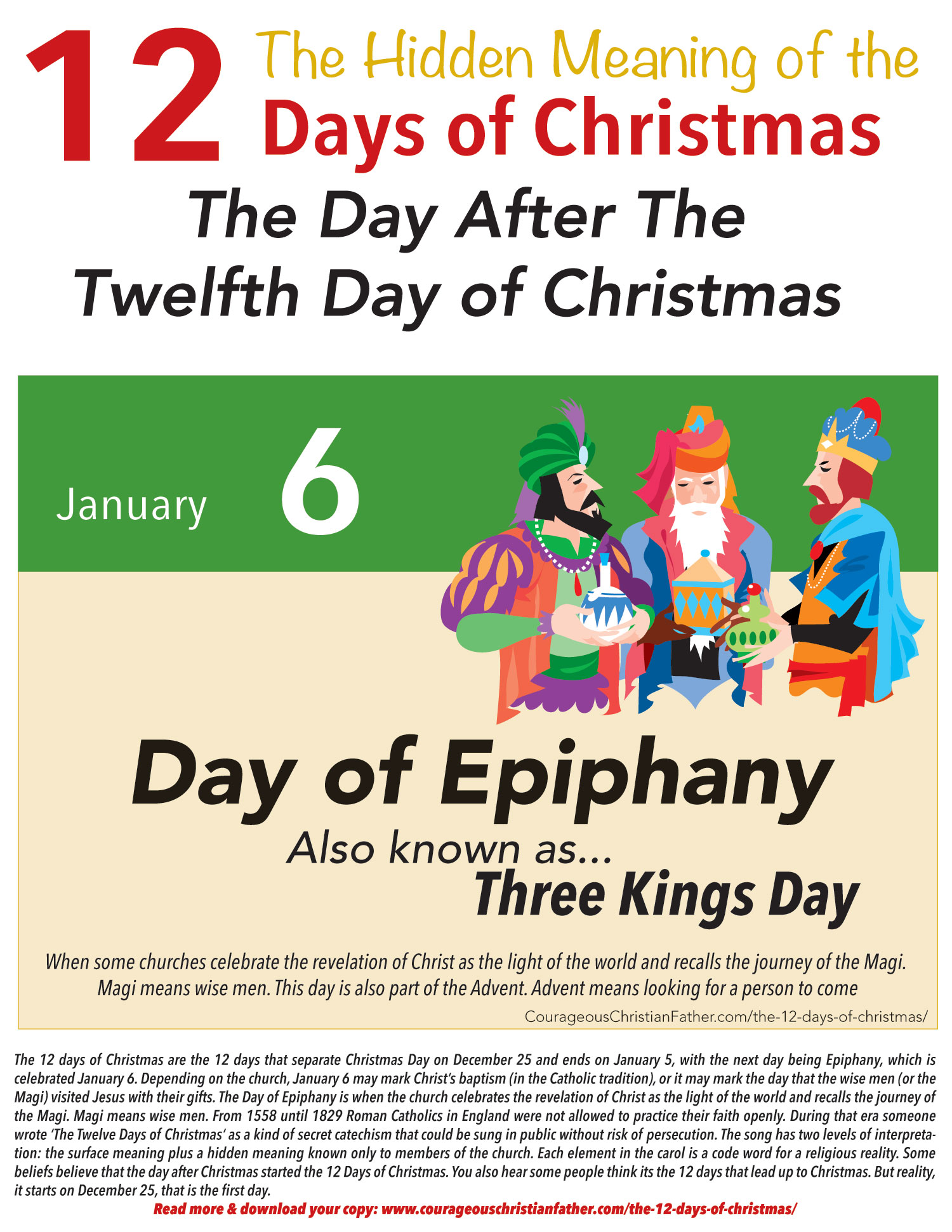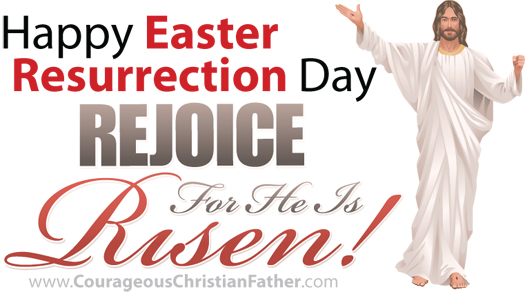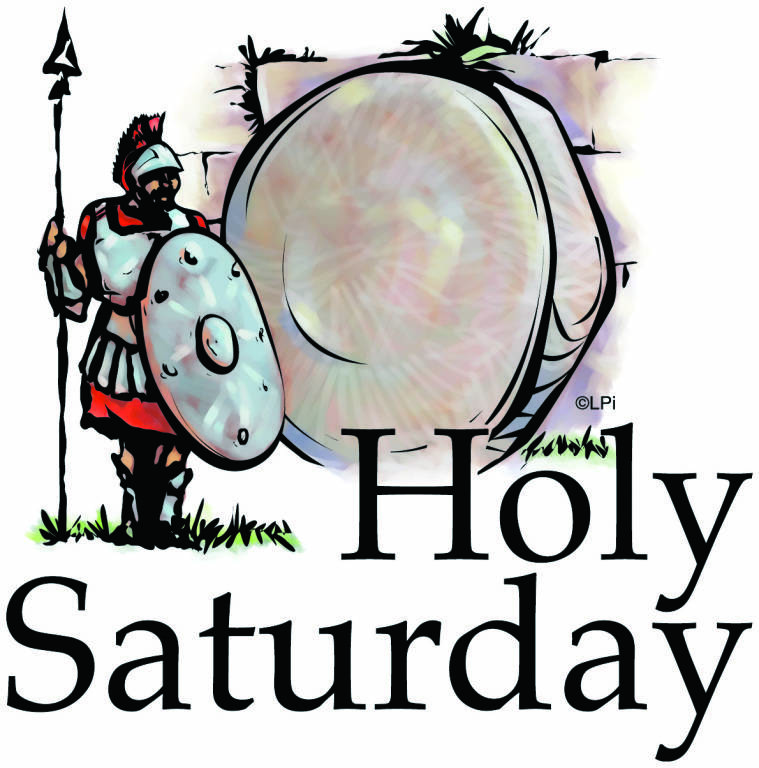Epiphany is celebrated on January 6 the day after the end of the 12 Days of Christmas. Also known as Three Kings Day and Old Christmas. #DayofEpiphany #ThreeKingsDay #OldChristmas
So what exactly is the Day of Epiphany?
(Three Kings Day)?

The 12 Days of Christmas are the 12 days that separate Christmas Day on December 25 and ends on January 5, with the next day being Epiphany, which is celebrated January 6. Depending on the church, January 6 may mark Christ’s baptism (in the Catholic tradition), or it may mark the day that the wise men (or the Magi) visited Jesus with their gifts.
The Day of Epiphany is when some churches celebrate the revelation of Christ as the light of the world and recalls the journey of the Magi. Magi means wise men. This day is also part of the Advent. Advent means looking for a person to come.
According to dictionary this is what Epiphany means …
e·piph·a·ny
əˈpifənē/ noun noun: Epiphany; noun: epiphany; plural noun: epiphanies
- the manifestation of Christ to the Gentiles as represented by the Magi (Matthew 2:1–12).
- the festival commemorating the Epiphany on January 6.
- a manifestation of a divine or supernatural being.
The Magi Visit the Messiah – Matthew 2:1-12
After Jesus was born in Bethlehem in Judea, during the time of King Herod, Magi from the east came to Jerusalem and asked, “Where is the one who has been born king of the Jews? We saw his star when it rose and have come to worship him.”
When King Herod heard this he was disturbed, and all Jerusalem with him. Not to mention, when he had called together all the people’s chief priests and teachers of the law, he asked them where the Messiah was to be born. “In Bethlehem in Judea,” they replied, “for this is what the prophet has written:
“‘But you, Bethlehem, in the land of Judah,
are by no means least among the rulers of Judah; for out of you will come a ruler
who will shepherd my people Israel.’”
Then Herod called the Magi secretly and found out from them the exact time the star had appeared. He sent them to Bethlehem and said, “Go and search carefully for the child. As soon as you find him, report to me, so that I too may go and worship him.”

After they had heard the king, they went on their way, and the star they had seen when it rose went ahead of them until it stopped over the place where the child was. When they saw the star, they were overjoyed. On coming to the house, they saw the child with his mother Mary, and they bowed down and worshiped him. Then they opened their treasures and presented him with gifts of gold, frankincense and myrrh. And having been warned in a dream not to go back to Herod, they returned to their country by another route.
Three Kings Day
Day of Epiphany is also known as Three Kings Day. A friend of mine, Lucy, in Puerto Rico told me a little bit about Three Kings Day (Dia de Los Tres Reyes Magos in Spanish) the children fill a box with fresh grass or hay. They then put this box underneath their bed, for the Wise Men’s camels. I am sure this day is celebrated differently in different parts of the country.
Christmas celebrants realize that the holiday season does not end on December 26 or even January 2. For many people, Christmas and New Year’s Eve are merely a prelude to the real celebration to come on Three Kings Day.
Three Kings Day, or Dia de Los Tres Reyes, is celebrated on January 6 to honor the wise men who visited and brought gifts to Jesus Christ. Also known as the Epiphany, the holiday marks the end of the Christmas season for many practicing Christians.
The Kings or Magi
Very little is known about the kings or magi. These kings, who are only mentioned once in the Gospel of Matthew, are never named. The story says they hail from the “East” and are guided to the manger by a mysterious light in the sky. They begin a journey to bring gold, frankincense and myrrh to the newborn king. Unbeknownst to many, the popular song “The 12 Days of Christmas” actually marks the 12 days following Christmas, ending on the Feast of the Epiphany, and not the 12 days preceding Christmas Day. Check out the Idden meaning of the 12 Days of Christmas
Rosca de Reyes
Many traditions are associated with Epiphany. Celebrants in Mexico serve Rosca de Reyes, an oval-shaped cake that symbolizes a crown. The cake has a small doll inside that represents baby Jesus and the hiding of Jesus from King Herod’s troops. Herod ordered his soldiers to seek out and murder all male infants born in Bethlehem in retaliation of the prophecy that a messiah would come and become the new King of Jerusalem.
Roscas can be made with dried and candied fruits too. These fruits symbolize the jewels that adorn real crowns. Whoever receives the plastic doll in his or her slice of cake is expected to throw a party on Día de la Candelaria, or Candlemas, (Candlemas Day), which occurs each year on February 2 in Mexico.
Gift Exchange
Unlike in the United States, where gifts are typically exchanged on Christmas Day, much of the Latin community exchange gifts on the eve of January 6. Puerto Rican children have been known to gather grass or straw in shoeboxes for the kings’ horses or camels. Some families display carvings and artwork of the three magi atop camels.
Many celebrants participate in Three Kings Day parades and festivals. Family gatherings and parties that would rival other special holidays are common as well. A special meal consisting of corn tamales and hot chocolate may be served, while others may enjoy black beans, picadillo and yucca.
Learn more why we give gifts on Christmas.
Who were the kings?
While the Bible does not indicate how many kings visited Jesus on the Epiphany, based on the number of gifts offered, historians believe there were three. Historians and theologians believe these kings were Babylonians, Persians or Jews from Yemen. In the Western Christian church, the kings go by the names of Melchior (a Persian scholar), Caspar (an Indian scholar) and Balthazar (an Arabian scholar). These kings also were said to have distinct physical characteristics. Caspar, who brought the gift of gold, was the oldest and sported a long, white beard. Middle-aged Melchior brought the gift of frankincense, while Balthazar, who brought myrrh, is believed to have been a dark-skinned young man around the age of 20.
The Feast of the Nativity and Theophany of Our Lord
Most Apostolic Churches will celebrate the birth of Jesus on January 6, Epiphany which they call it The Feast of the Nativity and Theophany of Our Lord. Theophany meaning a visible manifestation to humankind of God or a god.
Facts about Three Kings Day
January 6 marks the close of the Christmas celebration for many Christians. On this day, known as the Epiphany or Three Kings Day, people celebrate the visit of the magi to the Christ child. While some people are very familiar with this feast day and the customs surrounding it, others are less so. Here are some facts about Three Kings Day.
· Three Kings Day also goes by the names Little Christmas, Denha, Theophany, Día de los Reyes, and the Baptism of Jesus.
· The Epiphany marks the twelfth day of Christmas, falling 12 days after December 25.
· It is customary for some celebrants to bake ring-shaped cakes and hide a plastic baby figurine representing the baby Jesus inside. In Latin cultures, the cake is known as Rosca de Reyes, or “The King’s Ring.”
· The Bible does not specifically mention the number or names of the magi who visited Jesus. However, oral tradition has it that there were three and their names were Gaspar, Balthasar and Melchior.
· The gifts given to Christ were gold, frankincense oil and the resin myrrh. The gifts are symbolic of Jesus’s importance. The gold represents his royal standing, frankincense his divine birth and myrrh his mortality.
· Children may leave their shoes out on the Epiphany for presents, similar to the way stockings are hung. The shoes are filled with hay or treats for the Three Wise Men’s camels. In exchange, candies and toys are left for the children.
· Three Kings Day is one of the most significant religious holidays in Latin America, where the magi are more prominent figures than Santa Claus.
· In Britain and elsewhere, Twelfth Night is the evening that precedes the Epiphany, and Christmas decorations should remain up until then. Also, until as recently as the 1950s, Twelfth Night was a time for wassailing. Wassailers went house to house singing and wishing neighbors good health.
· Until the 19th century, the Epiphany was more important than Christmas Day.
· Roast lamb was traditionally served on the Epiphany.
The holiday season begins with Thanksgiving, and many people believe that the festivities come to a close after ringing in the new year. In fact, for the faithful, the Christmas season does not end until January 6 (January 12 in Eastern churches).
January 6 marks the celebration of the Epiphany, sometimes referred to as Three Kings Day, Little Christmas, the Baptism of Jesus, and Día de los Reyes. The Epiphany is celebrated 12 days after December 25. In fact, that is where the phrase the Twelve Days of Christmas, and the song of the same name, originated.
Christians believe that the real celebration of the holiday season does not begin until December 24 and then continues through Three Kings Day. While the four weeks preceding Christmas, also known as Advent, are supposed to be times of reflection and prayer in anticipation of the birth of Jesus Christ, the 12 days of Christmas are times of great celebration. On the Epiphany, children may leave their shoes out for presents in a similar fashion to the way stockings are hung. Gifts are exchanged, reminiscent of the three gifts the magi presented to the Christ child of gold, frankincense oil and a resin called myrrh. The gold represented Christ’s royal standing. The frankincense marked Christ’s divine birth. Finally, the myrrh stood for Christ’s mortality.
Many celebrants will bake ring-shaped cakes in which they will hide plastic baby figurines that are meant to symbolize Jesus Christ. The cake is called The Kings Ring, or Rosca de Reyes.
In Latin America, the three magi are more prominent figures than Santa Claus and are greatly revered by children and adults alike. Until the 19th century, the Epiphany may have been considered more important than Christmas day. However, those tides have largely shifted outside of Latin America and areas dominated by large populations of people who have Latin American heritage.
Christmas and New Year’s garner considerable attention during holiday celebrations, but Three Kings Day also is an important date on the calendar for faithful Christians.
Facts compliments of MetroCreative. TF201629 & TF211629
The tradition of the Epiphany
While some may think the holiday season ends once New Year’s Day comes and goes, for Christians, the season continues into January with the feast of the Epiphany.
The Epiphany occurs 12 days after Christmas, which falls on January 6 (or January 19 for some Orthodox churches that celebrate Christmas on January 7). The Epiphany celebrates the Three Kings, also known as the Three Wise Men, who visited Jesus shortly after his birth.
The Epiphany is celebrated by Catholics and Orthodox Christians. Among Hispanics, the day is known as El Día de los Reyes.
Many traditions are included in Epiphany celebrations. According to the Center for Christian Ethics at Baylor University, three historical traditions of the Epiphany include baking a “Kings’ Cake,” marking a door lintel with the Magi’s blessing, and participating in worship with lighted candles. Some families also exchange gifts on the Epiphany to commemorate the gifts of gold, frankincense and myrrh that the Three Wise Men presented to Jesus upon arriving at the manger.
Chalking doors
Celebrants of the Epiphany can mark their own doors, also called “chalking the doors.” This tradition is a centuries-old practice that serves as a request of Christ to bless the homes marked so that all those who dwell inside remain blessed throughout the year. The marking includes the first digits of the year, followed by the initials of the Magi – Caspar, Malchior and Balthazar – followed by the last digits of the year. In 2020 the formula should read: 20+C+M+B+20. Others believe the letters represent the abbreviation of the Latin phrase “Christus mansionem benedicat,” or “May Christ bless the house.
King cakes
King cakes vary by region. In Spain, local bakers make a special ring-shaped roll. In France, it is a flat almond cake with a toy crown cooked inside. In Mexico, bakers put a figure of Baby Jesus inside a cake. The person who finds the figure is awarded the honor of baking or providing the cake for the following year and hosting the Epiphany celebration.
Lighting candles
Individuals are urged to keep candles lit on the Epiphany. This is to symbolize how Jesus’ presence on Earth was comparable to light entering a darkened world.
The arrival of the New Year beckons an important religious celebration that extends the magic of the Christmas season.
Traditions Compliments of MetroCreative. TF181652
Closing on Epiphany
So as you can see there are a variety of ideas of what Epiphany is. Nonetheless, this day seems to deal with Christ in it somehow from His actual birth, to His baptist and to the wise men that came to visit Him. I know in the Baptist faith, we don’t do anything special for Epiphany.
We do not do Advent either because Advent looks to someone coming, as Baptist we know that His birth has already came. As most Advent celebrates the looking forward to His birth. As Baptist, we do know that He is coming again. His Second Coming! So we look to that. We also celebrate His birth as well but not in the form of Advent. Without the virgin birth of Christ, we would not be forgiven.
This brings me to a point. Anything and everything we do including relationships we must have Christ in it and Christ must be the central point of it all. All things should point to Christ. He is the one that died to save us from our sins. If it brings you away from Christ it is not meant for you!
Old Christmas
A Facebook post from The Museum of Appalachian dated January 6, 2016, I came across this on January 2, 2023. This is how it read …
January 6th—Twelve days after Christmas Day—is the day that many celebrate Epiphany, or “Old Christmas”. According to many Christians, on this date the Three Kings or “wise men,” arrived in Bethlehem—bringing gifts to the infant Jesus.
The observance of Epiphany goes back centuries, and when the Scots-Irish pioneers settled in the hills of Southern Appalachia, they continued to celebrate this holiday. Over time, however, the Appalachian people came to know the Day of Epiphany as “Old Christmas.” While many countries celebrate the day by giving traditional gifts, the Appalachian people observed “Old Christmas” in ways that were quite unique. Today, many might find these traditions to be superstitious, they were taken very seriously by the people of this region.
One belief concerning “Old Christmas” was that if a person would stay awake until midnight on Old Christmas Eve, then go out to a barn where animals were kept, they would hear the animals pray. Alex Stewart, a pioneer from the hills of East Tennessee, was one who celebrated this tradition.
He recalls, “On Old Christmas night at twelve o’clock, you go to where there’s any cattle, and you go and sit down and listen at them pray. I tried that twice. The first time, it liked to have scared me to death. They got to going on so, that I broke and run back to the house. But, I got to studying about it and then tried it again. Me and my oldest sister went together…we went down to the barn and sat down and waited till about twelve o’clock, and just slipped up right easy—didn’t make no racket. We had two milk cows, and lo and behold, they started groaning and going on—just moo-o-o-o-o moo-o-o-o-o, and we got scared and run to the house. Grandpa Stewart had told me they’d do that, but I hadn’t believed it. After I tried it twice, I saw they was something to it.”
According to the Appalachian people, that isn’t the only strange occurrence you’ll encounter on “Old Christmas.” Alex declared, “…and I don’t care how cold it is, nor how deep the ground is froze, elder bushes will sprout out of the ground on Old Christmas night. They’ll sprout out that night and never get no bigger till the sap rises in the spring of the year. If you don’t believe me, you find you a place where there’s a bunch of elders a growing and you look around underneath the bushes the night before Old Christmas, and you won’t see any sprouts. Then, you go back the next morning and you’ll see them sprouts a peeping through the ground everywhere—don’t matter how hard the ground is froze. I’ve checked that out myself. Oh! And don’t ever loan anything to nobody on Old Christmas, because you’re not apt to get it back.”
Today, very few recognize the Old Christmas traditions, but according to our friend Alex, they’ll hold true until the end of time.
See the other days …
Intro | First Day | Second Day | Third Day | Fourth Day | Fifth Day | Sixth Day | Seventh Day | Eighth Day | Ninth Day | Tenth Day | Eleventh Day | Twelfth Day | Day of Epiphany
DOWNLOAD A FREE PRINTABLE VERSION OF THE HIDDEN MEANING OF THE 12 DAYS OF CHRISTMAS!
First published January 6, 2018. Last updated or republished January 6, 2024.
Check out Courageous Christian Father’s Wish list on Amazon where you can purchase and this items sent directly to him and they will be used for the ministry.
Subscribe To Courageous Christian Father!
Don’t miss any blog posts! Subscribe today! You can subscribe via WordPress or by entering your email! Thank you!
Follow Courageous Christian Father on WordPress.comFollow Courageous Christian Father on Social Media
Recent Posts:
Below are some examples of blog entries from all the blogs that I do. (Courageous Christian Father, Steve Sews Stuff, SteveZ DuckZ, and SteveZ DesignZ).
Thank You For Reading Courageous Christian Father!
Thank you for reading. Please feel free to share and like this blog post.
Clipart: Unsplash, Pixabay, Pexels, Openverse, Adobe Express, Adobe Stock, FreePik, MetroCreative, and more. This site uses Amazon Affiliate Ads & Google Ads.
About the Author
Discover more from Courageous Christian Father
Subscribe to get the latest posts sent to your email.


